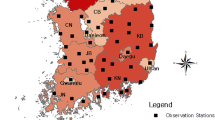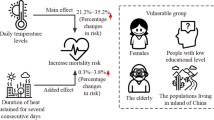Abstract
An ecological study and a case-crossover analysis were conducted to evaluate the impact of heat waves on nonaccidental deaths, and to identify contributing factors of population vulnerability to heat-related deaths in Jinan, China. Daily death data and meteorological data were collected for summer months (June to August) of 2012–2013. Excess mortality was calculated and multivariate linear regression models were used to assess the increased risk of heat waves on deaths. Univariate and multivariate logistic regression models were performed to estimate the odd ratios (ORs) of risk factors and their 95 % confidence intervals (CIs). Overall, heat waves were related to 24.88 % excess deaths of total nonaccidental deaths and 31.33 % excess deaths of circulatory diseases, with an OR of 16.07 (95 % CI 8.80–23.33) for total nonaccidental deaths and 12.46 (95 % CI 7.39–17.53) for deaths of circulatory diseases. The case-crossover analysis indicated that older people were more likely to die during heat waves (OR = 1.233, 95 % CI 1.076–1.413) and more deaths occurred outside a hospital during heat waves (OR = 1.142, 95 % CI 1.006–1.296). In conclusion, heat waves have caused excess deaths and significantly increased the risk of circulatory deaths. The risk factors identified in our study have implications for public health interventions to reduce heat-related mortality during extreme heat events.

Similar content being viewed by others
References
Analitis A, Michelozzi P, D’Ippoliti D et al (2014) Effects of heat waves on mortality: effect modification and confounding by air pollutants. Epidemiology 25(1):15–22. doi:10.1097/EDE.0b013e31828ac01b
Anderson GB, Bell ML (2011) Heat waves in the United States: mortality risk during heat waves and effect modification by heat wave characteristics in 43 U.S. communities. Environ Health Perspect 119(2):210–218. doi:10.1289/ehp.1002313
Baccini M, Biggeri A, Accetta G et al (2008) Heat effects on mortality in 15 European cities. Epidemiology 19(5):711–719. doi:10.1097/EDE.0b013e318176bfcd
Bai L, Ding GQ, Gu SH et al (2014) The effects of summer temperature and heat waves on heat-related illness in a coastal city of China,2011-2013. Environ Res 132:212–219. doi:10.1016/j.envres.2014.04.002
Ballester F, Corella D, Perez-Hoyos S et al (1997) Mortality as a function of temperature: a study in Valencia, Spain, 1991–1993. Int J Epidemiol 26(3):551–61. doi:10.1093/ije/26.3.551
Bart D, Lindsey A, Rochelle S et al (2009) Estimating the mortality effect of the July 2006 California heat wave. Environ Res 109(5):614–9
Basu R, Samet JM (2002) Relation between elevated ambient temperature and mortality: a review of the epidemiologic evidence. Epidemiol Rev 24(2):190–202. doi:10.1093/epirev/mxf007
Basu R, Feng WY, Ostro B (2008) Characterizing temperature and mortality in nine California counties, 1999–2003. Epidemiol 19:138–145
Basu R (2009) High ambient temperature and mortality: a review of epidemiologic studies from 2001 to 2008. Environ Heal 8:40–52. doi:10.1186/1476-069X-8-40
Bell ML, O’Neill MS, Ranjit N et al (2008) Vulnerability to heat-related mortality in Latin America: a case-crossover study in Sao Paulo, Brazil, Santiago, Chile and Mexico City, Mexico. Int J Epidemiol 37:796–804. doi:10.1093/ije/dyn094
Bittner MI, Matthies EF, Dalbokova D et al (2014) Are European countries prepared for the next big heat-wave? Eur J Pub Health 24(4):615–619. doi:10.1093/eurpub/ckt121
Bouchama A, Knochel JP (2002) Heat stroke. N Engl J Med 346(25):1978–1988. doi:10.1056/NEJMra011089
Bouchama A, Dehbi M, GamalM MF, ShoukriM MB (2007) Prognostic factors in heat wave-related deaths. A meta analysis. Arch Intern Med 167(20):2170–2176. doi:10.1001/archinte.167.20.ira70009
Chen K, Bi J, Chen J et al (2015) Influence of heat wave definitions to the added effect of heat waves on daily mortality in Nanjing, China. Sci Total Environ 506–507:18–25. doi:10.1016/j.scitotenv.2014.10.092
Christopher BF, Vicente RB, David JD, Katharine JM, Michael DM (2014) Climate change 2014-impacts, adaptation, and vulnerability. Cambridge University Press, New York
Dilaveris P, Synetos A, Giannopoulos G et al (2006) Climate impacts on myocardial infarction deaths in the Athens territory: the climate study. Heart 92(12):1747–1751. doi:10.1136/hrt.2006.091884
D’Ippoliti D, Michelozzi P, Marino C et al (2008) The impact of heat waves on mortality in 9 European cities: results from the EuroHEAT project. Environ Health 19(6):s286–287. doi:10.1097/01.ede.0000340332.18427.d0
Dufour A, Candas V. (2007). Ageing and thermal responses during passive heat exposure: sweating and sensory aspects. Eur J Appl Physiol100(1): 19–26.doi:10.1007/s00421-007-0396-9.
Hajat S, Kovats RS, Lachowycz K (2007) Heat-related and cold-related deaths in England and wales: who is at risk? Occup Environ Med 64:93–100. doi:10.1136/oem.2006.029017
Hales S, Kovats S, Lioyd S et al (2014) Quantitative risk assessment of the effects of climate change on selected causes of death,2030s and 2050s. WHO Press.22, Geneva
Hansen A, Bi P, Nitschke M, et al. (2011). Older persons and heat-susceptibility: the role of health promotion ina changing climate. Health Promotion Journal of Australia22 Special: s17-21.doi:10.1071/HE11417
Heat-related mortality-Chicago, July 1995. MMWR Morb Mortal Wkly Rep 1995; 44: 577–9
Hu G, Song H (2012) Analysis of Air-Temperature Variation Trend and Abrupt Change in Jinan Based on Mann-Kendall Test. J Univ OF JINAN ( Sci and Tech ) 26(1):96–101, in Chinese
Iny J, Fann N, Zanobetti A, Hubbell B (2014) Effect modification of ozone-related mortality risks by temperature in 97 US cities. Environ Int 73:128–134. doi:10.1016/j.envint.2014.07.009
Ishigami A, Hajat S, Kovats RS et al (2008) An ecological time-series study of heat-related mortality in three European cities. Environ Health Perspect 7:5–11. doi:10.1186/1476-069X-7-5
Keatinge WR, Coleshaw SR, Easton JC, et al. (1986). Increased platelet and red cell counts, blood viscosity, and plasma cholesterol levels during heat stress, and mortality from coronary and cerebral thrombosis. Am J Med. 81(795–800).doi:10.1016/0002-9343(86)90348-7
Kenny GP, Yardley J, Brown C et al (2010) Heat stress in older individuals and patients with common chronic diseases. CMAJ 182(10):1053–1060. doi:10.1503/cmaj.081050
Lin Y, Ho T, Wang Y (2011) Mortality risk associated with temperature and prolonged temperature extremes in elderly populations in Taiwan. Environ Res 111:1156–1163
Liu T, Xu YJ, Zhang YH, et al.(2013). Associations between risk perception, spontaneous adaptation behavior to heat waves and heatstroke in Guangdong province, China.BMC Public Health 13(913).doi:10.1186/1471-2458-13-913
Ma WJ, Zen WL, Zhou MG et al (2015) The short term effect of heat waves on mortality and its modifiers in China: An analysis from 66 communities. Environ Int 75:103–109. doi:10.1016/j.envint.2014.11.004
Macpherson CC (2014) Climate change matters. J Med Ethics 40(4):288–90. doi:10.1136/medethics-2012-101084
Medina-Ramón M, Zanobetti A, Cavanagh DP, Schwartz J (2006) Extreme temperatures and mortality: assessing effect modification by personal characteristics and specific cause of death in a multi-city case-only analysis. Environ Health Perspect 114(9):1331–1336. doi:10.1289/ehp.9074
Montero JC, Miron IJ, Criado IJ et al (2014) Difficulties of defining the term, “heat wave”, in public health. Int J Environ Health Res 23(5):377–379. doi:10.1080/09603123.2012.733941
O’Neill MS, Zanobetti A, Schwartz J (2005) Disparities by race in heat-related mortality in four US cities: The role of air conditioning prevalence. J Urban Health 82(2):191–197. doi:10.1093/jurban/jti043
O’Neill MS, Zanobetti A, Schwartz J (2007) Modifiers of the Temperature and Mortality Association in Seven US Cities. Am J Epidemiol 157(12):1074–1082. doi:10.1093/aje/kwg096
Rey G, Jougla E, Fouillet A et al (2007) The impact of major heat waves on all-cause and cause-specific mortality in France from 1971 to 2003. Int Arch Occup Environ Health 80:615–626. doi:10.1007/s00420-007-0173-4
Robinson PJ (2001) On the definition of a heat wave. J ApplMeteorol 40(4):762–775. doi:10.1175/1520-0450(2001)040<0762:OTDOAH>2.0.CO;2
Shi ZB, Dong XG, Shi XW, Ren GZ (2007) Climate characteristic of high temperature weather in Jinan in recent 50a. Meteorol Environ Sci 30:95–97, in Chinese
Son JY, Lee JT, Anderson GB, Bell ML (2012) The impact of heat waves on mortality in seven major cities in Korea. Environ Health Perspect 120:566–71. doi:10.1289/ehp.1103759
Stafoggia M, Francesco F et al (2006) Vulnerability to heat-related mortality: a multicity, population-based, case-crossover analysis. Epidemiology 17(3):315–323. doi:10.1097/01.ede.0000208477.36665.34
StafoggiaM FF et al (2008) Factors affecting in-hospital heat-related mortality: a multi-city case-crossover analysis. J Epidemiol Community Health 62:209–215. doi:10.1136/jech.2007.060715
Steffen W, Hughes L, Perkins S.(2014). Heat waves: hotter, longer, more often. Sydney, Climate Council of Australia Ltd.21-29
Sun XM, Sun Q, Zhou XF et al (2014) Heat wave impact on mortality in Pudong New Area, China in 2013. Sci Total Environ 493:789–794. doi:10.1136/jech.2007.060715
UNISDR (United Nations Office for Disaster Risk Reduction). (2015). The human cost of weather related disasters. Available http://www.unisdr.org/archive/46793.
William W, Thompson L, Lorraine C (2006) Epidemiology of seasonal influenza: use of surveillance data and statistical models to estimate the burden of disease. JID 194(Suppl 2):82–91. doi:10.1086/507558
Wnkleby MA, Jatulis DE, Frank E, Fortmann SP (1992) Socioeconomic status and health: how education, income, and occupation contribute to risk factors for cardiovascular disease. Am J Public Health 82(6):816–820. doi:10.2105/AJPH.82.6.816
Wu F, Jing YS, Li XY et al (2013) Effect of heat wave on the death-toll of cardiovascular diseases in Nanjing area. J EnvironHygiene 3(4):288–292, in Chinese
Youngmin K, Seunghun J (2006) A vulnerability study of the low-income elderly in the context of high temperature and mortality in Seoul, Korea. Science of the Total Environment 371:82–88. doi:10.1016/j.scitotenv.2006.08.014
Yu WW, Vaneckova P, Mengersen K et al (2010) Is the association between temperature and mortality modified by age, gender and socio-economic status? Sci Total Environ 408:3513–3518. doi:10.1016/j.scitotenv.2010.04.058
Zeng WL, Lao XQ, Rutherford S et al (2014) The effect of heat waves on mortality and effect modifiers in four communities of Guangdong Province, China. Sci Total Environ 482(483):214–221. doi:10.1016/j.scitotenv.2014.02.049
Zhang Y, Bi P, Sun Y et al (2012a) Projected Years Lost due to Disabilities (YLDs) for bacillary dysentery related to increased temperature in temperate and subtropical cities of China. J Environ Monit 14(2):510–516
Zhang NJ, Guo M, Zheng XY (2012b) China: awakening giant developing solutions to population aging. The Gerontol 57(5):589–596. doi:10.1093/geront/gns105, in Chinese
Zhang Y, Nitshke M, Bi P (2013) Risk factors for direct heat-related hospitalization during the 2009 Adelaide heat wave: a case crossover study. Sci Total Environ 442:1–5. doi:10.1016/j.scitotenv.2012.10.042
Author information
Authors and Affiliations
Corresponding authors
Rights and permissions
About this article
Cite this article
Zhang, J., Liu, S., Han, J. et al. Impact of heat waves on nonaccidental deaths in Jinan, China, and associated risk factors. Int J Biometeorol 60, 1367–1375 (2016). https://doi.org/10.1007/s00484-015-1130-7
Received:
Revised:
Accepted:
Published:
Issue Date:
DOI: https://doi.org/10.1007/s00484-015-1130-7




